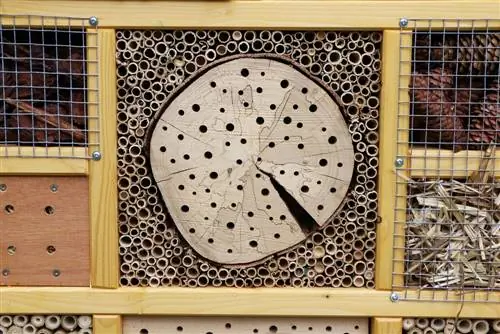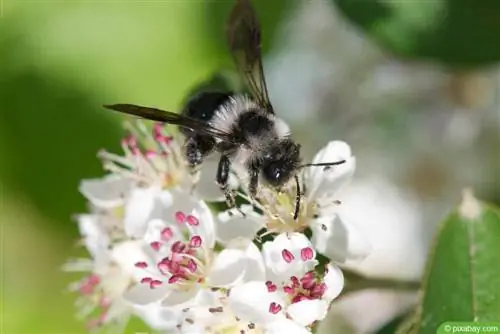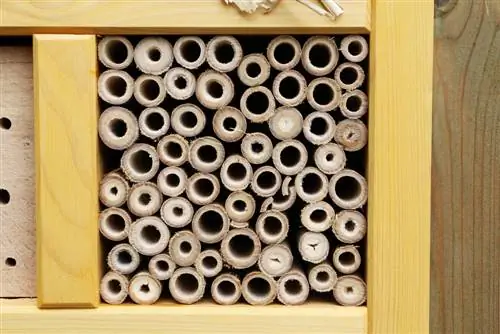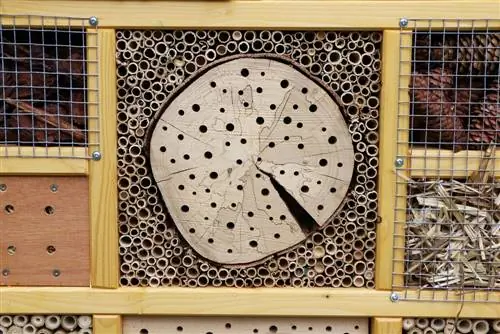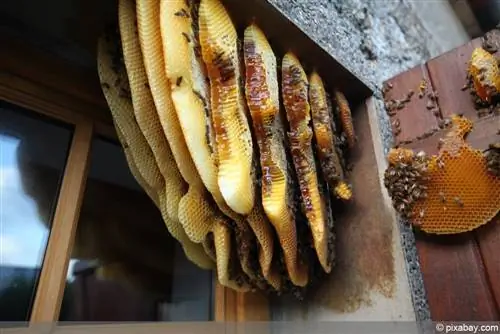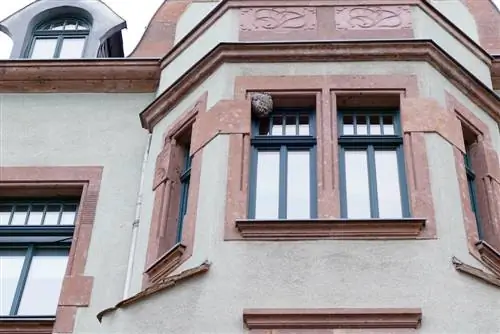- Author admin [email protected].
- Public 2023-12-17 03:39.
- Last modified 2025-06-01 06:48.
In order to offer wild bees a welcome nesting place, you can build your own wild bee house using simple means. These nesting aids can be built on your own with little time and expense. There are only a few limits to your imagination and creativity, but there are some important factors to consider during construction. Above all, the right choice of material and sufficient protection from rain are crucial.
Nesting behavior of wild bees
Wild bees are not limited to a specific solution when choosing their nesting place, but rather choose a suitable home in a variety of ways. Depending on the external circumstances and the size of the bee colony, the nest can vary greatly. Wild bees mostly nest in the ground, where the insects dig tunnels in the ground. Dry and sunny places are preferred as locations; these factors must also be taken into account when building a wild bee house. In addition, the insects also like to settle on vertical walls, which offer them good protection from predators. When the colony is smaller, wild bees often gnaw their nests into dead trees. Wild bee species that inhabit cavities are also very common; they prefer to settle in artificial wild bee houses.
- Mostly grow their brood cells in underground passages
- Are also happy with above-ground habitats
- Alternatively, wild bees look for burrows in cliff edges and steep walls
- Others nest in the cavities of cracks in walls
- Hollow trees are often preferred above ground
- Dead wood and the pith of woody stems also provide habitats
- Some species build free-standing nests made of resin
- It is also possible to build a nest out of mineral mortar
Material selection
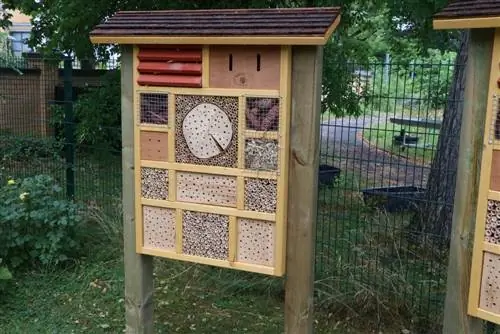
Permeable materials are very important, otherwise fungi will form in the tubes of wild bee brood if the water vapor cannot escape. Glass tubes that are used to observe nesting activities inside are particularly fatal. These unsuitable nesting aids often turn into a death trap for the offspring due to fungal infection. If wood is to be used as a material, then it must not be too fresh. If the holes are placed too close together, undesirable cracks will occur, which wild bees avoid. In addition, drilling into the end grain of tree sheaths promotes crack formation. Softwoods are not suitable because they are not very durable and their wood fibers splinter quickly. Perforated and hollow bricks are also unsuitable as nesting aids, as their holes are either square or diamond-shaped.
- Nesting aids should be based on nature
- Select breathable materials
- Only use well-seasoned wood
- Plan enough space for the drill holes
- Drilling into the longitudinal wood is useful
- Only splinter-free nesting passages are colonized
- Make sure the cut edges are clean and smooth
- Wild bees prefer the round holes in the interlocking tiles
- Free-standing and vertical structures are advantageous
- Disused bird nesting boxes are also useful
Select your place
Ideally, the nesting aids should be provided with a sturdy hanger to protect them from wind and weather. This means they are better protected against attacks from predators. A dry place is very important so that the front panels and inserts do not warp due to moisture penetrating from outside and thus become stuck. The spatial orientation of the location is also important; north-facing nesting aids are not popular. Shaded nests or nests that dangle in the wind are just as unpopular. Most species of wild bees overwinter in their nest and therefore need a place protected from extreme sub-zero temperatures.
- Either hang up or set up nesting aids in the selected place
- Permanently dry location, especially well protected from driving rain
- A free-standing wall, oriented from southeast to southwest, is ideal
- As sunny a place as possible, without annoying drafts
- Depending on the construction, it can also be easily placed on a window sill
- Nesting aids generally stay outside all year round
- Additional protection against heavy forest during the winter months
- Curtain reed mat or plywood panel
- Keep a small distance to allow air circulation
- Protection helps against both extreme weather conditions and bird damage
Hardwoods
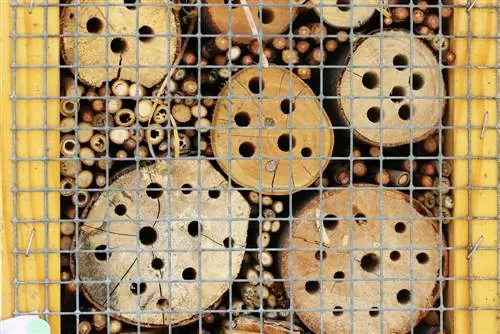
Blocks made of well-seasoned hardwood are ideal for the wild bee house; these are guaranteed to be colonized by insects. In addition, this wood is not prone to cracking, even if the distance between the holes is too narrow. It is also important to ensure that the wooden block is not completely drilled through. In order to be able to offer a home to as many wild bee colonies as possible, the diameter of the holes is crucial. Softwoods are completely unsuitable because the resin that escapes causes the filigree bee wings to stick together.
- The wood types beech, oak and ash are ideal
- Completely debarking pieces of wood
- Provided with holes in the longitudinal wood, where the bark used to be
- Diameter of the nesting tunnels should be 2-10 mm
- Distance should be 2.5-3 times the diameter of the drill bits
- Make sure you have sharp, high-quality wood drills
- This makes nesting passages smooth and splinter-free
- The deeper the drill holes, the better
- Drilling holes should vary in diameter
Tubes made of reeds and bamboo
Nesting aids made from reed and bamboo tubes are very easy to make. In this way, a lot of living space can be accommodated in a small space and offered to wild bees. The materials for this can be obtained from a conventional hardware store. If this nesting aid is hung on the wall at a distance, then the house wall behind it will not get dirty so quickly. In addition, the insects can then enter and exit via the back door, thereby providing additional protection from predators.
- Cut approximately 20 cm wide strips from reed or bamboo rolls
- Work with a fine saw to ensure splinter-free tubes
- Roll up the tubes tightly together
- Then tie them together tightly
- Use weatherproof materials for lacing
- Disused belts and robust fabrics are ideal
- Scrape out the entrances of the individual tubes well
- Drilling out the core of the bamboo tubes
- Pin small wooden slat at the back
- This creates enough distance from the wall
- Attach firmly to avoid rocking motion
Stems, tendrils and pithy tubes
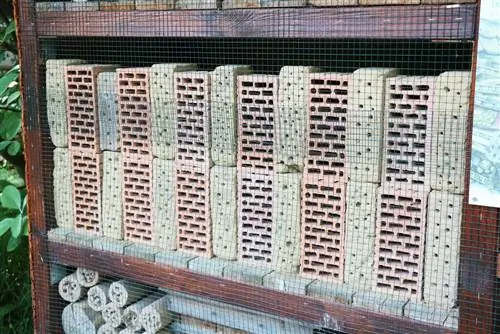
Some species of wild bees prefer to inhabit hollow stems, which is why the tendrils, tubes and stems of various plants are suitable as starting material for nesting aids. The wild bees dig the nesting tunnels into the soft marrow at will. These are set up standing and can be attached to many areas in the garden, on the house and on the terrace. If the stems are positioned horizontally, they are usually not colonized at all.
- Stems of blackberries, raspberries, reeds and buddleia are ideal
- Alternatively, tendrils of elderberry, mullein, motherwort and evening primrose are also possible
- Just break off the ends to allow the insects to get in
- Tie bundled to wooden sticks, drain pipes or garden fence
- Place in a sunny location in spring
Strong interlocking tiles
The interlocking tile is proven to be the oldest roofing material, which is made from fired clay. These bricks are interlocked on the sides and have round, longitudinal hollow chambers on the visible side. The punched edge is either curved, straight or round. The bricks offer good protection against rain as only the top one gets completely wet. - In this way, the entire roof can be made bee-friendly and a useful living space can be created for the insects.
- Stack the interlocking bricks to form a small tower
- Place in a protected location
- Ideal is under the canopy or in an open shed
- Makes a useful nesting aid with lots of holes
- Mason bees in particular settle here

